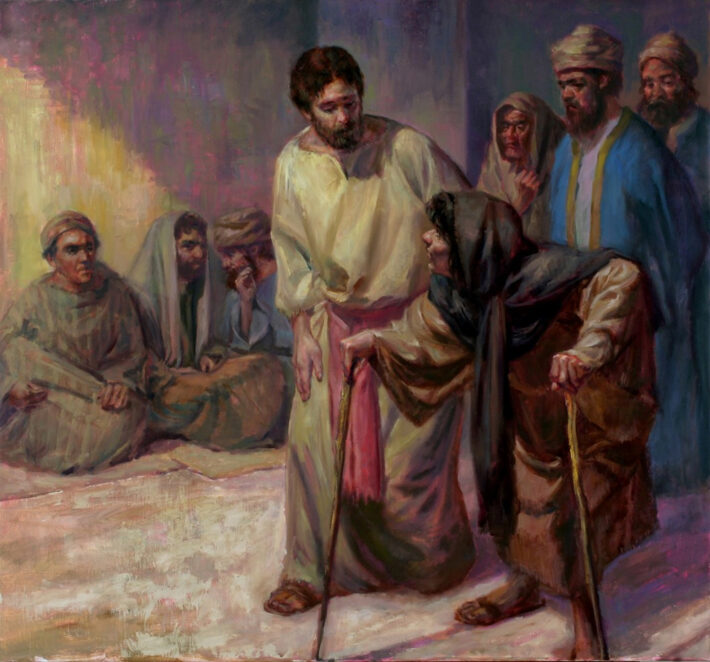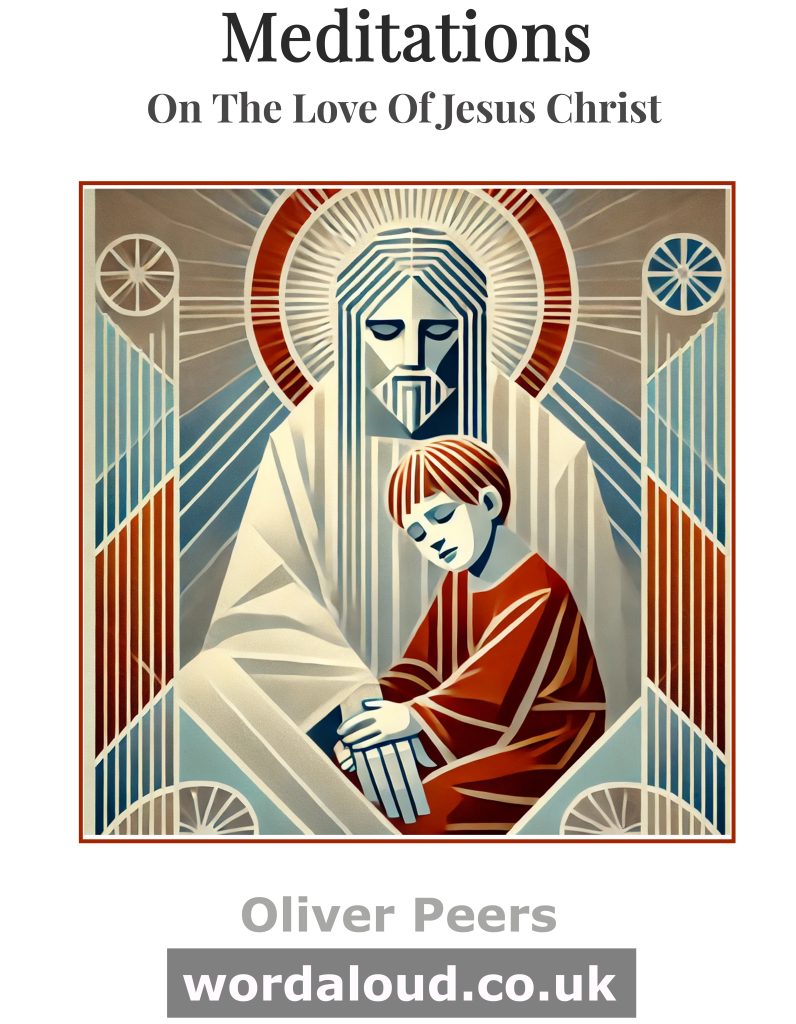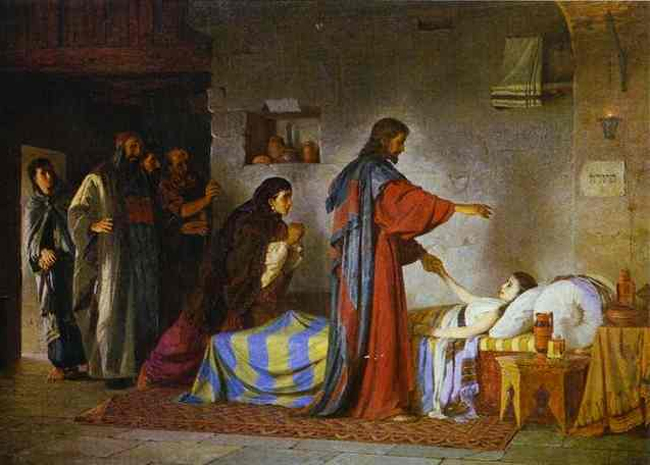Christian Art | Jesus Heals On The Sabbath In The Synagogue
Luke 13: 10-17 – Week 30 Ordinary Time, Monday (King James Audio Bible KJV, Spoken Word)
10 And he was teaching in one of the synagogues on the sabbath.
11 ¶ And, behold, there was a woman which had a spirit of infirmity eighteen years, and was bowed together, and could in no wise lift up herself.
12 And when Jesus saw her, he called her to him, and said unto her, Woman, thou art loosed from thine infirmity.
13 And he laid his hands on her: and immediately she was made straight, and glorified God.
14 And the ruler of the synagogue answered with indignation, because that Jesus had healed on the sabbath day, and said unto the people, There are six days in which men ought to work: in them therefore come and be healed, and not on the sabbath day.
15 The Lord then answered him, and said, Thou hypocrite, doth not each one of you on the sabbath loose his ox or his ass from the stall, and lead him away to watering?
16 And ought not this woman, being a daughter of Abraham, whom Satan hath bound, lo, these eighteen years, be loosed from this bond on the sabbath day?
17 And when he had said these things, all his adversaries were ashamed: and all the people rejoiced for all the glorious things that were done by him.
It was customary to go to the synagogue on the Sabbath, to read and study Scripture and praise God, and our Lord Jesus is observant, assuming a teaching role in the synagogue. It is in this context that the crippled woman becomes a type of Christ’s teaching. She has been an abject figure, bowed down for eighteen years. She does not come to the synagogue asking to be healed; she seems quite passive.
Jesus heals the woman with his words and with the laying on of hands. She is instantly healed, and now she is released from her infirmity she is made straight and enabled to praise God. In the context of the readings of Scripture, here we see Christ’s saving redemption in action, enabling a free and upright glorying of God. We catch a glimpse through the scene of Christ’s fulfilment of the Law.
The leader of the synagogue is indignant, lacking in charity and claiming that Jesus has violated the Sabbath laws. This, as Christ tells him, is hypocrisy. We know that it is also absurd, because this is Jesus.
The Sabbath was given to man as a space of rest within which man could worship God. The Sabbath rules are intended to enable man to gear his whole being without distraction toward man’s highest duty, to worship God. As Jesus has said, however: ‘The Son of Man is lord also of the Sabbath.’ (Mark 2: 28) The Sabbath is ours to use with freedom and intelligence, as we offer ourselves to God.
The deeper, hidden truth is that Jesus himself is the Lord of the Sabbath. He is the Son of God; he has authority to restructure our relationship with God and the Sabbath. The Sabbath points toward the Son as it does to the Father. In healing on this Sabbath day, Jesus centres Scripture upon himself.
Concluding Prayer | Love Revealed By Jesus Christ
Father, Creator of all that is good,
you have called men to work in your world,
and by their cooperation to better the condition of mankind.
Grant that we may always work together as children of your family,
and love all men as our brethren.
Through Christ our Lord.
![]()

King James Audio Bible | Endnotes
Release From Satan On The Sabbath Day
Luke 13:10-17 narrates a remarkable story of a woman who had been suffering from a crippling condition for eighteen years. The passage describes how Jesus, while teaching in the synagogue on the Sabbath day, saw the woman and called her forward. Jesus then laid hands on her, and she was instantly healed. This miraculous act sparked a controversy between Jesus and the religious leaders who accused Jesus of breaking the Sabbath law.
Bound By Satan | Released By Jesus
The story of the woman with the crippling condition is an illustration of the power of Jesus to release people from the grip of Satan. The passage tells us that the woman had been bound by Satan for eighteen years, and Jesus set her free from this oppression. This statement is significant because it suggests that the cause of the woman’s illness was not a physical condition but a spiritual one. The Bible describes Satan as a fallen angel who seeks to deceive, oppress, and destroy people’s lives.
The healing of the woman in Luke 13:10-17 has profound implications for our understanding of the Sabbath Law. The religious leaders of Jesus’ time had become so focused on the strict observance of the Law that they had lost sight of its true purpose. They had turned the Sabbath into a burden rather than a blessing, and they accused Jesus of breaking the Law by healing on the Sabbath day.
Jesus responded to their accusation by pointing out that they themselves had no qualms about untying their animals and leading them to water on the Sabbath day. Jesus argued that if it was permissible to care for animals on the Sabbath, how much more was it appropriate to release a woman from the bondage of Satan on the same day?
This episode highlights the importance of understanding the true purpose of the Sabbath law. In the book of Exodus, we read that the Sabbath was given as a day of rest and worship. It was meant to be a time for people to cease from their work and focus on their relationship with God and their families.
Jesus’ healing of the woman on the Sabbath challenges a legalistic understanding of the Law and highlights the true purpose of the Sabbath. Jesus demonstrates that the Sabbath is not just a day of rest but also a day of liberation and salvation. By healing the woman, Jesus showed that the Sabbath is a day of freedom from the oppression of Satan and sin.
The story of the woman with the crippling condition has inspired many Christians throughout history. Saint Thomas Aquinas writes that Jesus’ healing of the woman on the Sabbath is a sign of his divine power and mercy. Aquinas argues that Jesus’ actions demonstrate that the Sabbath is a day of mercy and compassion, not just a day of legalistic observance.
The Sabbath In The Old Testament
The story of the woman with the crippling condition is deeply rooted in the Old Testament, particularly in the prophetic writings. The prophets frequently spoke of God’s desire to release His people from the oppression of sin and evil, and to restore them to wholeness and freedom.
The prophet Isaiah speaks of the coming of the Messiah who will bring freedom and healing to the people of God. In Isaiah 61:1-3, he writes:
‘The Spirit of the Sovereign Lord is on me, because the Lord has anointed me to proclaim good news to the poor. He has sent me to bind up the brokenhearted, to proclaim freedom for the captives and release from darkness for the prisoners, to proclaim the year of the Lord’s favour and the day of vengeance of our God, to comfort all who mourn, and provide for those who grieve in Zion—to bestow on them a crown of beauty instead of ashes, the oil of joy instead of mourning, and a garment of praise instead of a spirit of despair. They will be called oaks of righteousness, a planting of the Lord for the display of his splendour.’
This passage is seen by many as a Messianic prophecy, which Jesus claimed for himself in Luke 4:16-21. The healing of the woman with the crippling condition can be understood as a fulfilment of this prophecy, as Jesus releases the woman from the oppression of Satan and restores her to wholeness.
The Old Testament also contains many examples of God’s desire to release His people from bondage and oppression. The book of Exodus tells the story of how God delivered the Israelites from slavery in Egypt and brought them to the Promised Land. The Sabbath law itself is rooted in this story, as God commanded His people to rest on the seventh day as a reminder of their deliverance from slavery.
The book of Deuteronomy, which contains a restatement of the law for a new generation of Israelites, emphasizes the importance of observing the Sabbath. In Deuteronomy 5:12-15, we read:
‘Keep the sabbath day to sanctify it, as the Lord thy God hath commanded thee. Six days thou shalt labour, and do all thy work: But the seventh day is the sabbath of the Lord thy God: in it thou shalt not do any work, thou, nor thy son, nor thy daughter, nor thy manservant, nor thy maidservant, nor thine ox, nor thine ass, nor any of thy cattle, nor thy stranger that is within thy gates; that thy manservant and thy maidservant may rest as well as thou. And remember that thou wast a servant in the land of Egypt, and that the Lord thy God brought thee out thence through a mighty hand and by a stretched out arm: therefore the Lord thy God commanded thee to keep the sabbath day.
The Sabbath was a day of rest, not only for the Israelites but also for their servants, animals, and even strangers within their gates. The Sabbath was a sign of God’s covenant with His people and a reminder of His creation and redemption.
In addition to the Sabbath day, there were also other Sabbath years and Jubilee years that were observed in the Old Testament. Every seventh year was a Sabbath year, during which the land was to lie fallow and debts were to be forgiven. The Jubilee year, which occurred every 50 years, was a year of release and restoration, during which all land was to be returned to its original owners and all slaves were to be set free.
The Sabbath laws were intended to promote justice and equity in Israelite society, as well as to provide rest and refreshment for all who observed them. However, over time, the Sabbath laws became burdensome and legalistic, and the religious leaders of Jesus’ time had added numerous restrictions and regulations to them.
The Opposition Of Satan
The Old Testament contains many references to Satan and his attempts to deceive and destroy God’s people.
One of the most well-known passages is found in the book of Job, where Satan challenges God to allow him to test Job’s faith. Satan inflicts terrible suffering on Job, but Job remains faithful to God and is ultimately rewarded for his faithfulness.
Another significant passage is found in the book of Zechariah, where the prophet has a vision of Joshua the high priest standing before God. Satan is there to accuse Joshua, but God rebukes Satan and declares that He has chosen Joshua as a sign of His grace and mercy.
In the New Testament, Satan is portrayed as a powerful and malevolent force who seeks to deceive and destroy God’s people. In the Gospels, we see Satan tempting Jesus in the wilderness and later possessing Judas Iscariot to betray him.
However, we also see Jesus’ power and authority over Satan. In Luke 10:18-19, Jesus declares that he has seen Satan fall like lightning from heaven, and Jesus gives his disciples authority to trample on snakes and scorpions and to overcome all the power of the enemy.
The book of Revelation also contains vivid descriptions of Satan and his final defeat at the hands of Christ. The book speaks of Satan being bound for a thousand years, and of his ultimate destruction in the lake of fire.







